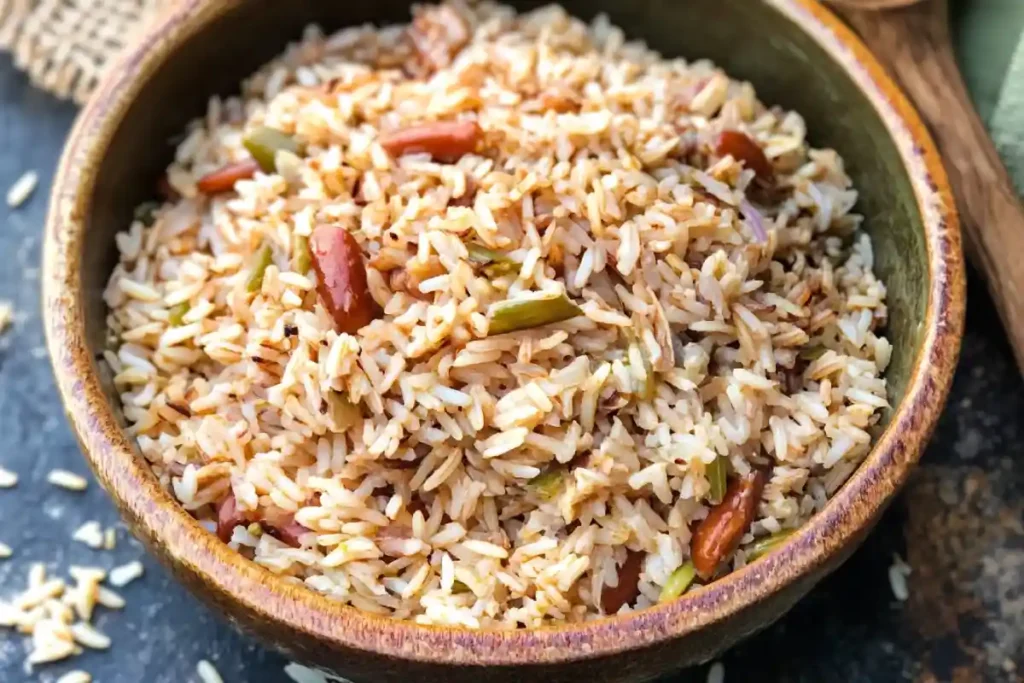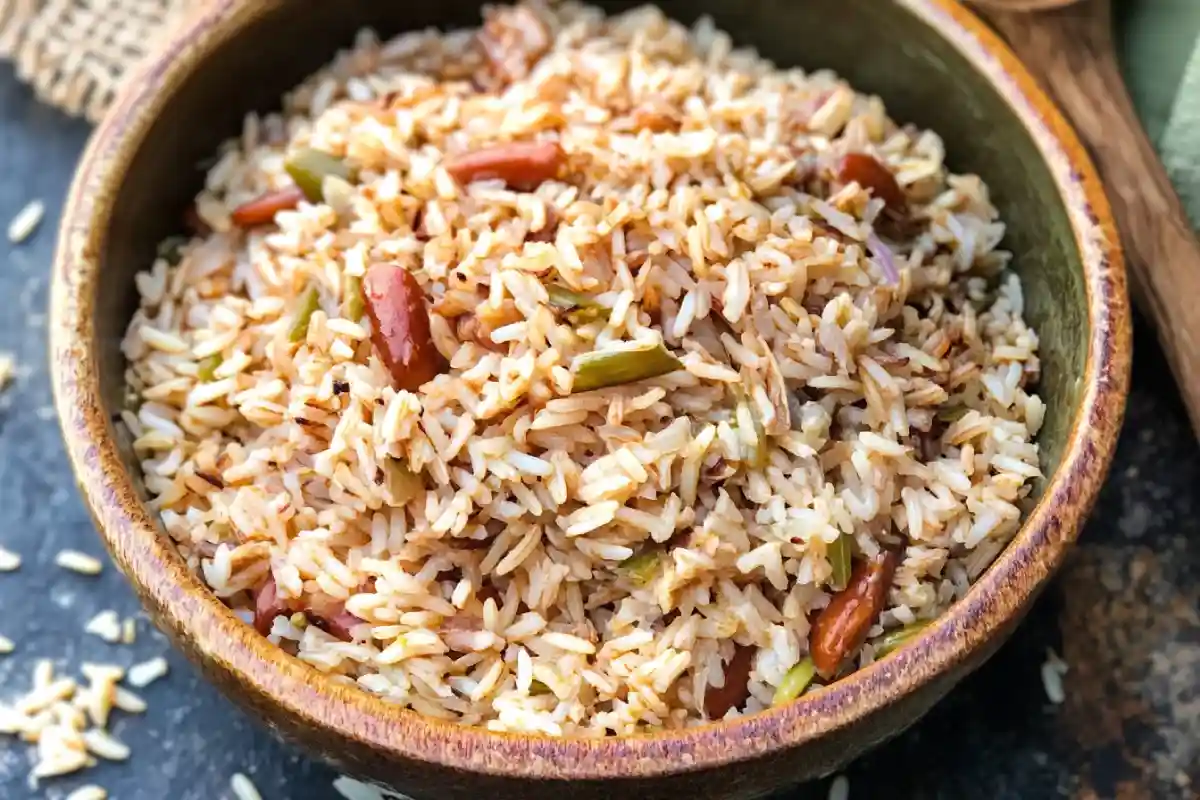
Table of Contents
Choosing the best rice for jambalaya can make or break texture. I test-drove long-grain white, parboiled, and brown rice across three pots of jambalaya, tracking hydration and stovetop loss. Verdict: plain U.S. long-grain delivers classic fluff, while parboiled stays forgiving for beginners—and each needs a different stock-to-rice ratio you’ll find below.
What Kind of Rice is Best for Jambalaya?
Choosing the best rice for jambalaya isn’t just a matter of taste—it’s essential to getting the right texture, flavor absorption, and authenticity. Because rice is the core of this iconic dish, it must hold up to simmering, mixing, and absorbing rich spices without turning soggy. Therefore, knowing which rice works—and which ones don’t—makes all the difference.
Best Rice Types for Jambalaya
Let’s break down the top rice types commonly used in jambalaya and how they perform:
| Rice Type | Texture | Flavor Absorption | Best For |
|---|---|---|---|
| Long-Grain White Rice | Light and fluffy | Excellent | Traditional Cajun Jambalaya |
| Jasmine Rice | Slightly sticky | Good | Quick, weeknight recipes |
| Basmati Rice | Aromatic but soft | Moderate | Fusion dishes, not ideal here |
| Parboiled Rice | Firm and non-sticky | Great | One-pot Cajun-style dishes |
| Medium/Short-Grain | Sticky and soft | Poor | Avoid for jambalaya |
As you can see, long-grain white rice is usually the top pick for a reason. It stays firm during cooking and doesn’t become mushy, even with bold seasonings and heavy proteins. That’s why many traditional recipes, like this Authentic Louisiana Jambalaya, rely on it to carry the dish.
In contrast, short or medium-grain rice tends to absorb too much liquid too quickly. This often leads to clumps and a gummy texture—not ideal when you’re aiming for a balanced, fluffy dish.
Why Parboiled Rice Deserves a Mention
Although long-grain is the most traditional choice, parboiled (or converted) rice is also gaining popularity. Because it’s partially cooked and dried before packaging, it holds its shape beautifully and resists overcooking. That makes it perfect for busy home cooks who still want to nail the best rice for jambalaya.
In summary, here are the key takeaways:
- Stick to long-grain white rice for authentic texture.
- Use parboiled rice for foolproof, fluffy results.
- Avoid short-grain rice, which tends to get too sticky.
Cooking Techniques – How to Make the Best Rice for Jambalaya
Once you’ve picked the best rice for jambalaya, it’s time to cook it right. Even the best choice can fall short if handled improperly. That’s why applying the right technique matters just as much as your ingredients. Thankfully, there are a few proven steps that help ensure perfectly fluffy, flavorful rice in every bite.
Top Tips for Perfect Jambalaya Rice
To get restaurant-level results at home, follow these essential methods:
- Toast the rice before adding liquid to enhance nutty flavor and reduce sogginess.
- Use the correct rice-to-liquid ratio, which prevents gumminess or dryness.
- Simmer gently, keeping the pot covered to trap steam and flavor.
- Avoid over-stirring, as it breaks down the rice and leads to mush.
Recommended Cooking Ratios
| Rice Type | Water/Stock Ratio | Cooking Time | Notes |
|---|---|---|---|
| Long-Grain White Rice | 1:2 | 20–25 min | Keep lid closed for fluffiness |
| Parboiled Rice | 1:1.75 | 20 min | Great for holding firm texture |
| Jasmine Rice | 1:1.5 | 15–18 min | More fragrant, but slightly sticky |
Moreover, if you’re following a hearty, one-pot style like this chicken and sausage jambalaya recipe, you’ll want to layer your ingredients. Always start by browning the meat, sautéing aromatics, and then stirring in the rice and liquid last. This not only builds flavor but also ensures even cooking.
In the end, no matter which method you use—stovetop or oven-baked—the technique is what turns your ingredients into a flavorful, cohesive dish. With proper handling, even a simple easy jambalaya recipe can feel gourmet, proving once again that technique and the best rice for jambalaya go hand in hand.
FAQs About Jambalaya Rice
Even with the right ingredients and cooking tips, it’s normal to have questions—especially if you’re making jambalaya for the first time. Because rice plays such a central role, getting it just right can make or break the dish. Below, we’ve answered some of the most common questions to help you confidently choose the best rice for jambalaya and prepare it properly.
What kind of rice is used in jambalaya?
Traditionally, long-grain white rice is the go-to for jambalaya. That’s because it stays separate when cooked, absorbs flavor beautifully, and creates the ideal texture. While some may try other types, long-grain consistently delivers the most reliable results.
What kind of rice is used in Cajun cooking?
In Cajun recipes, long-grain rice is also the most common choice. Since Cajun jambalaya doesn’t include tomatoes, the rice needs to stand up to meat, stock, and spice alone. This makes long-grain ideal because it holds its shape and soaks in the bold seasoning without becoming sticky.
How do you keep rice from getting mushy in jambalaya?
To prevent mushiness:
Avoid over-stirring while cooking
Use the correct rice-to-liquid ratio
Let the dish rest before serving
Most importantly, use the best rice for jambalaya, like parboiled or long-grain rice
These steps help maintain that fluffy, non-sticky consistency every time.What type of rice is in Zatarain’s jambalaya?
Zatarain’s jambalaya mix typically uses parboiled long-grain rice. This type of rice is partially cooked before packaging, which helps it stay firm and fluffy, even during extended simmering. It’s a great option if you’re looking for foolproof results with minimal effort.
Conclusion – The Final Verdict on the Best Rice for Jambalaya
At the end of the day, crafting the perfect jambalaya isn’t just about the sausage, spices, or smoky flavor—it all starts with the best rice for jambalaya. While it may seem like a simple ingredient, rice serves as the foundation that holds the dish together. Therefore, getting it right is absolutely essential.
As we’ve seen, long-grain white rice remains the top choice for most traditional and modern jambalaya recipes. It stays light and fluffy, allowing each grain to soak up the spices without becoming sticky or overcooked. However, parboiled rice also deserves a spotlight. Its forgiving nature and firm texture make it an excellent option, especially for beginners or when cooking large batches.
Whether you’re preparing a simple sausage jambalaya recipe or exploring a classic Cajun jambalaya, your rice choice will influence the texture, taste, and overall success of your dish. Moreover, even specialty versions—like baked or plant-based jambalaya—rely on rice to maintain balance and flavor.
Ultimately, choosing the best rice for jambalaya not only honors tradition but also ensures that every spoonful delivers warmth, comfort, and authenticity. Once you’ve found your preferred variety and nailed the technique, jambalaya quickly becomes a go-to meal you’ll want to recreate again and again.

